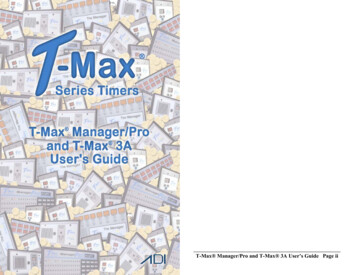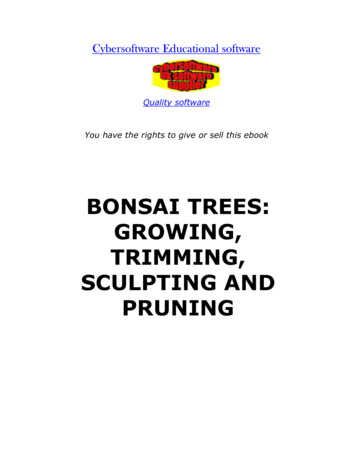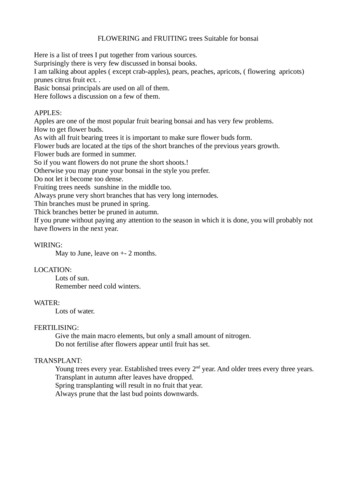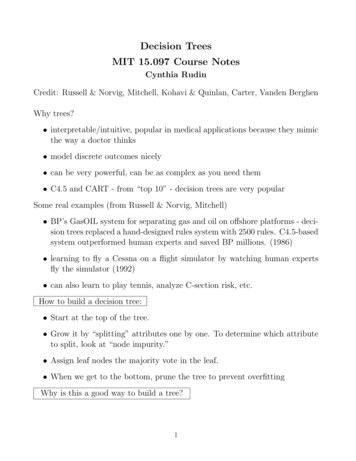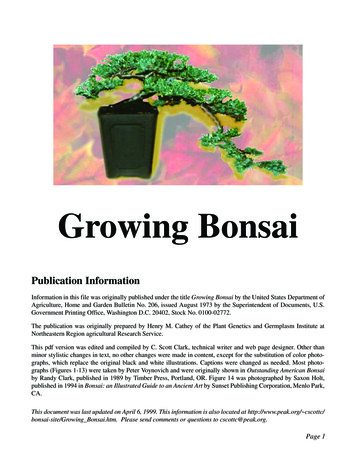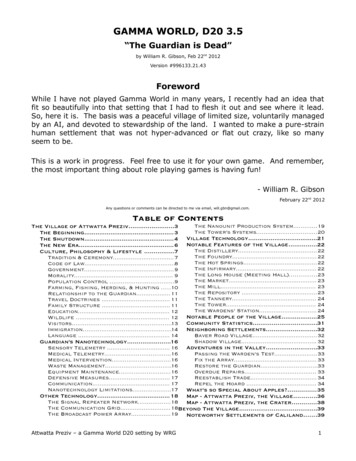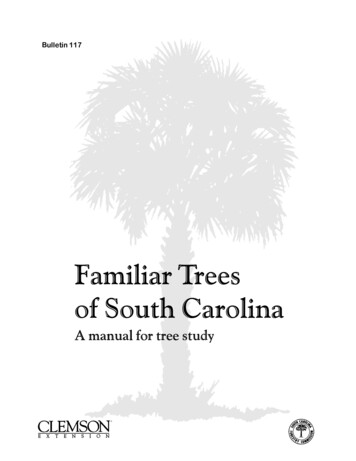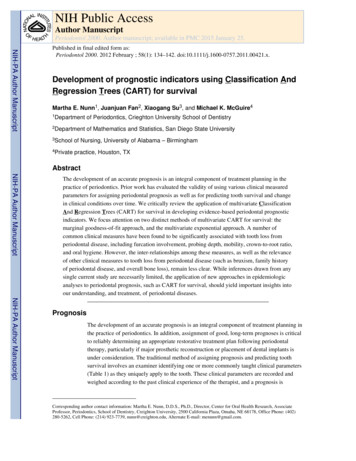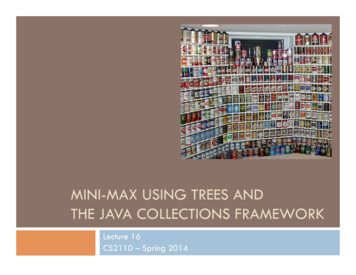
Transcription
MINI-MAX USING TREES ANDTHE JAVA COLLECTIONS FRAMEWORKLecture 16CS2110 – Spring 2014
Important Dates.2 April 10 --- A4 due (Connect 4, minimax, trees)April 15 --- A5 due (Exercises on different topics, tobe posted by May 28)April 22 --- Prelim 2.May 1 --- A6 due (Butterfly, graphs, search).May 12 --- Final exam.
Today’s topics3Connect 4. Use of trees (game-tree) and recursion to make aConnect 4 AI. Mini-max.Java Collections Framework Generic Data Types
Game States: s1, s2, s5(Also the nodes in the tree) Actions: edges in the tree Leaf node: ? Depth of tree at node s1: ?Game State and Tree4x o xoox“Game State s1”X’s turnx o xoox x“Game State s2”x o xoox x“Game State s3”O’s turnx o xo o ox x“Game State s5”x o xo x ox“Game State s4”
Games and Mini-Max5 Minimizing the maximum possible loss. Choose move which results in best state Select highest expected score for youAssume opponent is playing optimally too Willchoose lowest expected score for you
Game Tree and Mini-Max6x o xooxX’s turn(max) xoxO’s turn(min) x oo o x xX’s turn(max) o xox x o xoox x o x o xo x ox x oxoWhat move should x make?x o xoox x x o xo x ox x o x xx o x x o xo x o oo o o oox x o x x x o o x o xx o xxo x oo x ooox x o o x x o xx ox o xx ox x
Properties of Mini-max7b possible moves and m steps to finish game. Time complexity?O(bm) Space complexity?O(bm) (depth-first exploration)For tic-tac-toe, b 9, and m 9.For chess, b 35, m 100 for "reasonable" games!!
Mini-Max is used in many games!8 Stock Exchange!
Robot Programming Can we have a robot prepare arecipe? For example “Avogado”, an Italian dish.Natural Language à Actions.What do we need? Parsing(to understand natural language) Trees : Mini-max to figure out whatactions it can do? (some of them lead tosuccess and some of them to disaster)
Robot ProgrammingAshutosh Saxena
Today’s topics11Connect 4. Use of trees (game-tree) and recursion to make aConnect 4 AI. Mini-max.Java Collections Framework Generic Data Types
Textbook and Homework12 Generics: Appendix BGeneric types we discussed: Chapters 1-3, 15Homework: Use Google to find out about the oldJava Vector collection type. Vector has been“deprecated”, meaning that it is no longerrecommended and being phased out. What moremodern type has taken over Vector’s old roles?
Generic Types in Java13 When using a collection (e.g.LinkedList, HashSet,HashMap), we generally have a singletype T of elements that we store in it (e.g.Integer, String)Before Java 5, when extracting anelement, had to cast it to T before wecould invoke T's methodsCompiler could not check that the castwas correct at compile-time, since it didn'tknow what T wasInconvenient and unsafe, could fail atruntime Generics in Javaprovide a way tocommunicate T, thetype of elements in acollection, to thecompiler§ Compiler can checkthat you have usedthe collectionconsistently§ Result: safer andmore-efficient code
Exampleold14/** Return no. of chars in the strings incollection of strings c. */static int cCount(Collection c) {int cnt 0;Iterator i c.iterator();while (i.hasNext())cnt cnt ((String)i.next()).length();return cnt;new}/** Return no. of chars in c */static int cCount(Collection String c) {int cnt 0;Iterator String i c.iterator();while (i.hasNext()) {cnt Cnt ((String)i.next()).length();return cnt;}
Example – nicer looking loopnewold15/** Return no. of chars in the strings in* collection c of strings. */static int cCount(Collection c) {int cnt 0;Iterator i c.iterator();while (i.hasNext())cnt cnt ((String)i.next()).length();return cnt;}/** Return the number of characters incollection c. */static int cCount(Collection String c) {int cnt 0;for (String s: c)cnt cnt s.length();return cnt;}
Using Generic Types16 T is read, “of T” Example: Stack Integer is read, “Stack of Integer”.Here the “T” is “Integer”.The type annotation T indicates that all extractions from thiscollection should be automatically cast to TSpecify type in declaration, can be checked at compile time Can eliminate explicit castsIn effect, T is a parameter, but it does not appear wheremethod parameters appear
Advantage of Generics17 Declaring Collection String c tells us somethingabout variable c (i.e. c holds only Strings) This is true wherever c is used The compiler won’t compile code that violates thisWithout use of generic types, explicit casting must be used A cast tells us something the programmer thinks is true at asingle point in the code The Java virtual machine checks whether the programmer isright only at runtime
Subtypes: Example18Stack Integer not asubtype ofStack Object ButStack Integer isa subtype of Stack(for backwardcompatibility withprevious Javaversions)Stack Integer s new Stack Integer ();s.push(new Integer(7));// Following gives compiler errorStack Object t s; Stack Integer s new Stack Integer ();s.push(new Integer(7));// Compiler allows thisStack t s;
Programming with Generic Interface Types19public interface List E {// Note: E is a type variablevoid add(E x);Iterator E iterator();}public interface Iterator E {E next();boolean hasNext();void remove();}To use interface List E , supply a type argument, e.g.List Integer All occurrences of the type parameter (E in this case) are replaced bythe type argument (Integer in this case)
Generic Classes20public class Queue T extends AbstractBag T {private java.util.LinkedList T queue new java.util.LinkedList T ();public void insert(T item) { queue.add(item); }public T extract()throws java.util.NoSuchElementException{ return queue.remove(); }public void clear() { queue.clear() }public int size() { return queue.size(); }}
Generic Classes21public class InsertionSort Comparable T {/** Sort x */public void sort(T[] x) {for (int i 1; i x.length; i ) {// invariant is: x[0.i-1] is sorted// Put x[i] in its rightful positionT tmp x[i];int j;for (j i; j 0 &&x[j-1].compareTo(tmp) 0; j j-1)x[j] x[j-1];x[j] tmp;}}}
Java Collections Framework22 Collections: holders that letyou store and organizeobjects in useful ways forefficient accessPackage java.utilincludes interfaces andclasses for a generalcollection framework Goal: conciseness§ A few concepts that arebroadly useful§ Not an exhaustive set ofuseful concepts The collectionsframework provides§ Interfaces (i.e., ADTs)§ Implementations
JCF Interfaces and Classes23 Interfaces ClassesCollectionSet (no duplicates)SortedSetList (duplicates OK)HashSetTreeSetArrayListLinkedListMap erableListIterator
interface java.util.Collection E 24 public int size(); Return number of elementspublic boolean isEmpty(); Return true iff collection is emptypublic boolean add(E x); Make sure collection includes x; return true if it haschanged (some collections allow duplicates, some don’t)public boolean contains(Object x); Return true iff collection contains x (uses method equals)public boolean remove(Object x); Remove one instance of x from the collection; return trueif collection has changedpublic Iterator E iterator(); Return an Iterator that enumerates elements of collection
Iterators: How “foreach” works25The notation for(Something var: collection) { } is syntactic sugar. Itcompiles into this “old code”:Iterator E i collection.iterator();while ( i.hasNext()) {E var i.Next();. . . Your code . . .}The two ways of doing this are identical but the foreach loop isnicer looking.You can create your own iterable collections
java.util.Iterator E (an interface)26 public boolean hasNext(); Return true if the enumeration has more elementspublic E next(); Return the next element of the enumeration Throws NoSuchElementException if no next elementpublic void remove(); Remove most recently returned element by next() fromthe underlying collection Thros IllegalStateException if next() not yet called or ifremove() already called since last next() Throw UnsupportedOperationException if remove()not supported
Additional Methods of Collection E 27public Object[] toArray() Return a new array containing all elements of collectionpublic T T[] toArray(T[] dest) Return an array containing all elements of this collection;uses dest as that array if it can Bulk Operations: public boolean containsAll(Collection ? c); public boolean addAll(Collection ? extends E c); public boolean removeAll(Collection ? c); public boolean retainAll(Collection ? c); public void clear();
java.util.Set E (an interface)28 Set extends Collection Set inherits all its methodsfrom CollectionA Set contains no duplicatesIf you attempt to add() anelement twice then thesecond add() will returnfalse (i.e. the Set has notchanged) Write a method that checksif a given word is within aSet of words Write a method thatremoves all words longerthan 5 letters from a Set Write methods for the unionand intersection of twoSets
Set Implementations29java.util.HashSet E (a hashtable) Constructorsn public HashSet();n public HashSet(Collection ? extends E c);n public HashSet(int initialCapacity);n public HashSet(int initialCapacity,float loadFactor);java.util.TreeSet E (a balanced BST [red-black tree]) Constructorsn public TreeSet();n public TreeSet(Collection ? extends E c);n .
java.util.SortedSet E (an interface)30SortedSet extends SetFor a SortedSet, the iterator() returns elements in sorted order Methods (in addition to those inherited from Set): public E first();n Return first (lowest) object in this set public E last();n Return last (highest) object in this set public Comparator ? super E comparator();n Return the Comparator being used by this sorted set ifthere is one; returns null if the natural order is beingused
java.lang.Comparable T (an interface)31 public int compareTo(T x);Return a value ( 0), ( 0), or ( 0)n ( 0) implies this is before xn ( 0) implies this.equals(x)n ( 0) implies this is after xMany classes implement Comparable String, Double, Integer, Char,java.util.Date, If a class implements Comparable then that is consideredto be the class’s natural ordering
java.util.Comparator T (an interface)32 public int compare(T x1, T x2);Return a value ( 0), ( 0), or ( 0)n ( 0) implies x1 is before x2n ( 0) implies x1.equals(x2)n ( 0) implies x1 is after x2Can often use a Comparator when a class’s natural order isnot the one you want String.CASE INSENSITIVE ORDER is a predefinedComparator java.util.Collections.reverseOrder() returns a Comparatorthat reverses the natural order
SortedSet Implementations33 java.util.TreeSet E constructors:n public TreeSet();n public TreeSet(Collection ? extends E c);n public TreeSet(Comparator ? super E comparator);n .Write a method that prints out a SortedSet of words in orderWrite a method that prints out a Set of words in order
java.util.List E (an interface)34 List extends Collection items accessed via their indexMethod add() puts its parameter at the end of the listThe iterator() returns the elements in list-orderMethods (in addition to those inherited from Collection): public E get(int i); Return the item at position i public E set(int i, E x); Place x at position i, replacing previousitem; return the previous itemvalue public void add(int i, E x);n Place x at position index, shifting items to make room public E remove(int index); Remove item at position i, shiftingitems to fill the space; Return the removed item public int indexOf(Object x);n Return index of the first item in the list that equals x (x.equals())
List Implementations. Each includes methods specific toits class that the other lacks35 java.util.ArrayList E (an array; doubles the length each timeroom is needed)Constructorsn public ArrayList();n public ArrayList(int initialCapacity);n public ArrayList(Collection ? extends E c);java.util.LinkedList E (a doubly-linked list)Constructorsn public LinkedList();n public LinkedList(Collection ? extends E c);
Efficiency Depends on Implementation36 Object x list.get(k); O(1) time for ArrayList O(k) time for LinkedList list.remove(0); O(n) time for ArrayList O(1) time for LinkedList if (set.contains(x)) . O(1) expected time for HashSet O(log n) for TreeSet
What if you need O(1) for both?37 Database systems have this issue They often build “secondary index” structures Forexample, perhaps the data is in an ArrayList But they might build a HashMap as a quick way to finddesired items The O(n) lookup becomes an O(1) operation!
Today’s topics Connect 4. ! Use of trees (game-tree) and recursion to make a Connect 4 AI. ! Mini-max. J
